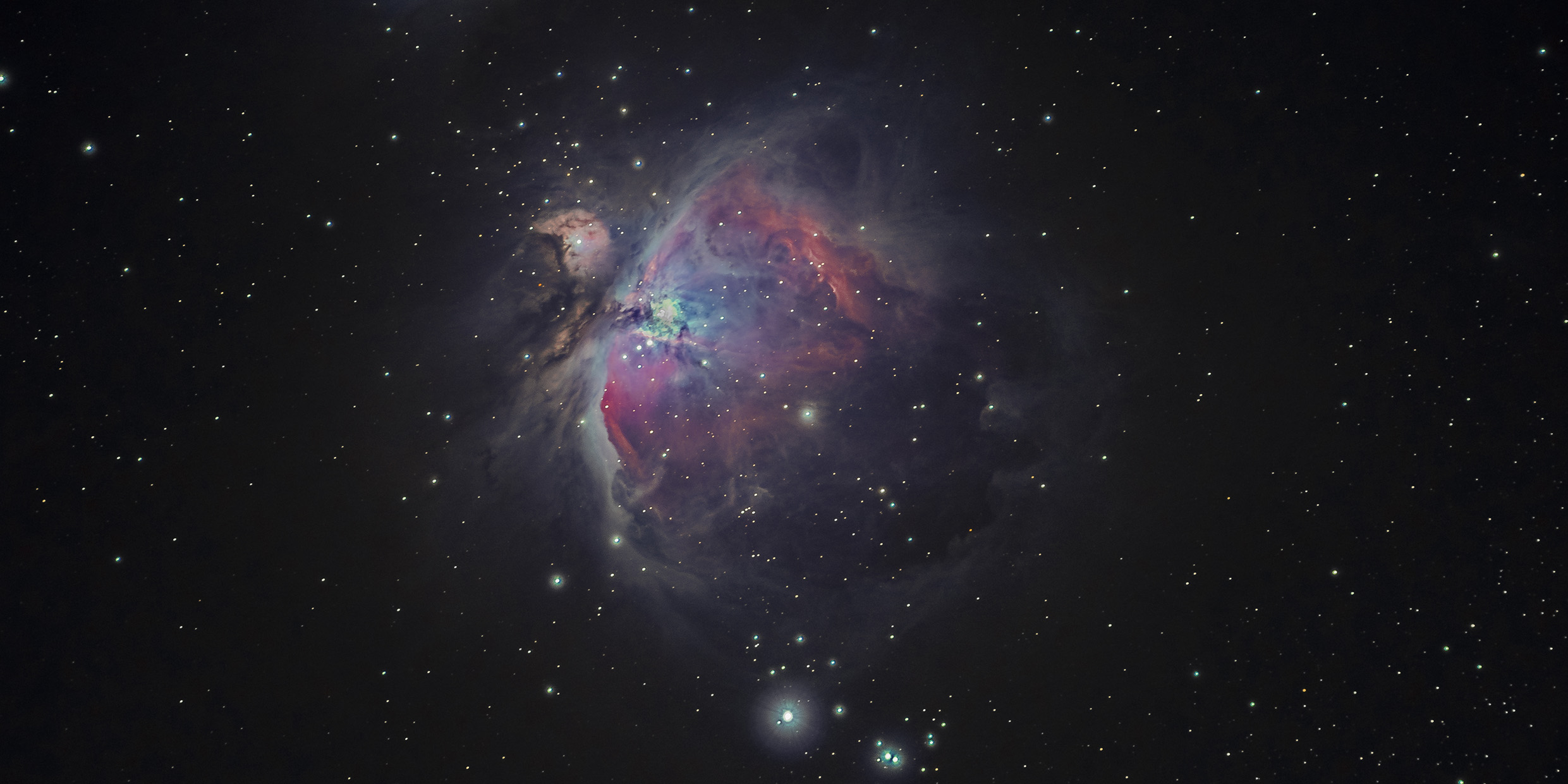Originally published 18 July 1983.
Orion the Hunter, the Giant, the pursuer of the Pleiades, is a familiar figure in the night sky. Even the neophyte stargazer will recognize the three bright stars of Orion’s belt, and the triad of stars that are the sword dangling at his hip. If the night is clear you might notice that the middle star of the sword lacks the sharp definition of the other stars. Binoculars will show that the “star” is not a star at all, but a blur of greenish light. Observatory photographs record a swirling drapery of luminous gas.
This is the Great Nebula in Orion, a gas cloud of cosmic dimensions, more than 20,000 times wider than our entire Solar System. Radio telescopes reveal that the Great Nebula is just one bright corner of an immense dark cloud that fills the body of Orion. In that dark ocean of gas, brilliant blue-white stars burn like island jewels.
It is in clouds such as this that astronomers believe stars and planets are born, pulled together by gravity from the stuff of the clouds. The hot young stars of Orion are newcomers on the cosmic scene, infants still wrapped in swaddling clothes of glowing gas. Even now, new stars are being born in the heart of the nebula.
A stellar breeding ground
The Orion nebula lies far beyond the Solar System. It is hundreds of times more distant than the nearest stars, but it is the closest of these star-forming regions. This stellar nursery offers astronomers an unparalleled opportunity to study the process of star formation.
Almost all of the atoms in these great interstellar gas clouds are hydrogen and helium, the lightest of the elements and the most common substances in the universe. They were created, according to current theories, fifteen or twenty billion years ago in a “Big Bang” explosion from a singular and infinitely dense seed of energy. Using well-known laws of physics, astronomers can calculate the conditions which existed in the earliest moments of the universe, and reconstruct the creation of matter from energy that occurred at that time. The calculations rule out the creation of elements heavier than helium, with the possible exception of small amounts of lithium and beryllium.
If the universe today contained only hydrogen and helium, as in the early days, there would be no planet Earth with a metallic core and a rocky crust. And the planet’s surface would not be softened by leaves of grass, alive with the chemistry of oxygen and carbon.
In the clouds of Orion astronomers can map the presence of carbon, oxygen, nitrogen, and tiny grains of dust. We are ourselves made of such stuff. If only hydrogen and helium were created in the first moments of the universe, where did these heavy elements come from?
The secret of the heavy elements lies in the burning that goes on at a star’s core. Astronomers have a fairly confident theoretical picture of how stars burn. The terrible reality of hydrogen bombs confirms the correctness of their calculations. The likely truth is this — stars produce their prodigious energy by fusing heavy elements from light ones.
A natural fusion reactor
Like the clouds of gas out of which they form, the stars are mostly hydrogen. In the enormous temperatures that prevail at a star’s core, hydrogen nuclei are fused together to form helium. In the process of fusion, some of the hydrogen’s mass is turned into pure energy. And it is the energy of fusion, flowing out from a star’s core, that makes the star shine.
In stars like the sun, carbon will be the ultimate ash of this nuclear burning. In the most massive stars, elements as heavy as iron can be forged from lighter nuclei. The stars are great pressure cookers, kettles that boil up from a simmering soup of hydrogen the very elements of which the earth and life are made.
But these elements are locked up in the prison of a star’s core. How did they get to be a part of the Orion gas cloud? Or of the grass?
An explosive death
At the end of their lives massive stars die violent deaths, blowing themselves apart in colossal detonations called supernovas. In the enormous energies generated by these stellar explosions, elements even heavier than iron can be fused from lighter elements. All of this nuclear debris — the elements fused in the normal burning of the star and the heavier elements produced in the star’s violent death — is flung into space, to become part of the great gas and dust clouds of the galaxy, perhaps to become part of some future star or planet.
As we look at Orion in the night sky, we are looking at our past, at the birth of suns and planets in dusty corners of the galaxy. The Earth, with its wealth of heavy elements, could not exist if generations of massive short-lived stars had not lived and died within the arms of the Milky Way galaxy before the Solar System was born.
Walt Whitman was literally correct when he sang “I believe a leaf of grass is no less than the journey-work of the stars.” The earth, the grass, every creature that draws breath under the sun, we are all of us made of star-ash.



